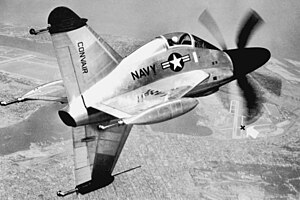| XFY Pogo | |
|---|---|
| Role | Experimental VTOL fighter aircraft |
| Manufacturer | Convair |
| First flight | 5 November 1954 (first conversion flight) |
| Primary user | United States Navy |
| Produced | 1954 |
| Number built | 1 prototype |
Contents
|
Design and development
After World War II, the Cold War prompted top United States Army and Navy to study VTOL operations. It was envisaged to protect task forces, convoys or any fleet, even without aircraft carriers, by placing VTOLs on any ship. These fighters would be housed within a conical protective housing, saving limited deck space available aboard ships. They would provide first line of airborne defense and reconnaissance capability, before more aircraft could be scrambled to help.[1]In May 1951, Lockheed and Convair were awarded contracts in the attempt to design, construct, and test two experimental VTOL fighters that would be suitable for use by the Armed forces. Although contract stipulations stated that each manufacturer have two fighters, each was only able to construct one, with Lockheed producing the XFV, and Convair producing the XFY, nicknamed the "Pogo".
Operational history
Testing and evaluation

Promotional photo for Convair
Throughout the next few weeks, Coleman logged almost 60 hours in test flights in the Pogo, and by August, the test was moved to outdoor conditions. On 1 August 1954, Coleman logged two outdoor test flights, the second flying 150 ft (45.7 m) into the air, and shortly after he flew 70 takeoff–landing drills at the Naval Auxiliary Air Station in Brown Field, California. The first conversion to horizontal flight took place on 5 November 1954.[2][N 1]
Upon later flights with longer durations, flaws in the design were found. Due to the Pogo's lightweight design, and the lack of spoilers and air brakes, the aircraft lacked the ability to slow down and stop efficiently after moving at high speeds. Landing was also a problem, as the pilot had to look back behind himself during a landing to properly stabilize the craft.
It became evident that even if technical problems could be overcome, contemporary VTOL aircraft would be flown only by the most experienced pilots. Thus, it was not feasible to place VTOL fighters—as previously hoped for—on every ship. As jet engined fighters approached Mach 2, turboprop VTOL fighter became disadvantaged with only half the top speed. Due to these problems, the XFY Project was put on hiatus.[4]
Later testing
Although a test flight was made on 19 May 1955, it again ended with failure, and on 1 August 1955, the project formally concluded. The last flight of the Pogo took place in November 1956.Survivors
The Pogo was moved to the National Air and Space Museum in Suitland, Maryland in 1973, where it currently resides.Specifications (XFY-1)
General characteristics- Crew: 1
- Length: 22 ft 11 in (10.66 m)
- Wingspan: 27 ft 7¾ in (8.43 m)
- Height: ft in (m)
- Wing area: 427 ft² (39.7 m²)
- Empty weight: 11,700 lb (5,310 kg)
- Max takeoff weight: 16,250 lb (7,370 kg)
- Powerplant: 1× Allison YT40-A-16 turboprop engine, 5,500 hp (17,000 lbs thrust)
- Propellers: 3-bladed contra-rotating propellers
- Maximum speed: 610 mph (530 kn, 980 km/h) at 15,000 ft (4,600 m)
- Cruise speed: ≈400 mph (350 kn, 640 km/h)
- Range: ≈400 mi (350 nmi, 640 km) cruising at 33,000 ft (10,000 m)
- Service ceiling: 43,600 feet (13,300 m)
- Max wing loading: 38.1 lb/ft² (186 kg/m²)
- Minimum power/mass: 0.34 hp/lb (560 W/kg)
- Guns: 4 × 20mm (0.79 in) cannon, or
- Rockets: 48 × 2.75 in (70 mm) Mk 4 Folding-Fin Aerial Rockets




No comments:
Post a Comment